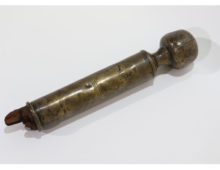Tagged with Wars and warfare
Resource : The Fighting Temeraire
JMW Turner is one of Britain’s best loved artists. He became known as the ‘painter of light’ due to his trademark style and use of colour in landscapes and seascapes. The Fighting Temeraire, one of his most famous oil paintings, shows the warship Temeraire being towed by a steam-powered tug on its last ever journey before being broken up. It is said to symbolise the decline of Britain’s naval power, the passing of the ‘glorious’ age of sail and the growth of ‘modern’ technology in an increasingly industrialised Britain. The industrial revolution and the history of the Royal Navy were therefore both saluted, through Turner’s revolutionary brand of romantic landscape painting.
Resource : The death of Major Peirson, 6 January 1781
In 1781, France invaded the Channel Island of Jersey. It was successfully defended by the British – an important victory at a time when they were failing in their war with America (American War of Independence) and about to lose control of their American colonies. This painting celebrates the victory and commemorates the death of Major Francis Peirson and his refusal to surrender.
Resource : The Battle of Vertières
In the late 1700s, the western part (St. Domingue) of the Caribbean island of Hispaniola was under French colonial rule. It had long been a major centre of sugar production on plantations using enslaved African labour. In 1791, Toussaint Louverture led the first – and only – successful uprising of slaves, in St Domingue. After a series of bloody conflicts and traumas with European colonial powers, St Domingue was renamed Haïti and became the first independent Black republic in 1804. These events became known as the Haitian revolution and played an important role in the decline of the Transatlantic slave trade. This lithograph depicts the Battle of Vertières in 1803, the final engagement between Haiti’s revolutionaries and Napoleon’s French forces.
Resource : Memorial to Joseph Blanco White
Joseph Blanco White was a Spanish theologian, writer and poet. He campaigned against intolerance in different ways: against Napoleonic invasion of Spain, for the religious right to convert between churches (which he did from Catholic priesthood to Anglicanism), and in support of the independence of South American countries from Spanish colonial rule. He is best remembered for his sonnet Night and Death which he dedicated to Samuel Coleridge.
Resource : Dartmoor Prison and English Barracks
Dartmoor prison was built between 1806 and 1809, mainly to confine thousands of prisoners of war. It was built in Princetown, a bleak part of Dartmoor and an ideal location because of its remoteness. It was designed by Daniel Asher Alexander, with buildings arranged like the spokes in a wheel, surrounded by a high perimeter wall. It was one of Britain’s first purpose-built prisons designed for 6,000 prisoners, and still remains a prison today, though now with a maximum capacity of just 659.
Resource : Statue of Simón Bolívar
This is a statue of the South American revolutionary leader Simón Bolívar. Bolívar became known as El Libertador (‘the liberator’) and founding father of many modern South American countries, such as Venezuela, Bolivia and Columbia. He sought to harness the ideas and independence movements of earlier revolutions (including the French and American revolutions), and find a way to bring them to Central and South America – calling on the written word, the sword, and his own potent charisma to seize opportunities at a time of upheaval and war.
Resource : Bonaparte at the Pont d’Arcole, Antoine-Jean Gros
Napoleon rose to power during the French Revolution, crowning himself Emperor of France in 1804. He had ambitions to carve out a vast empire and dynasty, and successfully invaded and conquered countries across the European continent in a series of bloody battles, before he was finally defeated at the Battle of Waterloo in 1815. These became known as the Napoleonic wars.
Resource : Martha Washington Doll
Martha Washington was the first ‘First Lady’ of the USA. Although the term ‘First Lady’ was not introduced until much later, Martha Washington was known as ‘Lady Washington’, in recognition of her status as the wife of the USA’s first President, George Washington.


